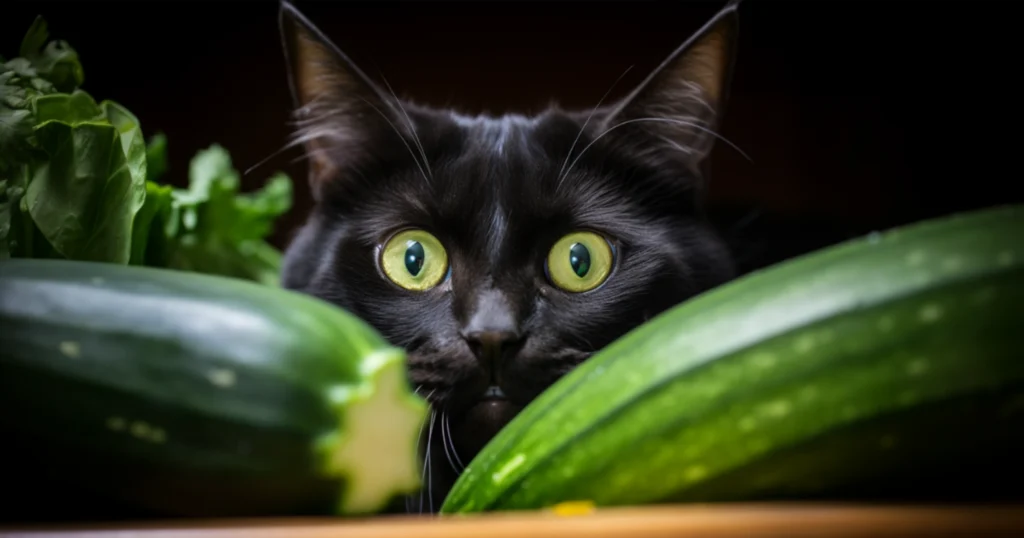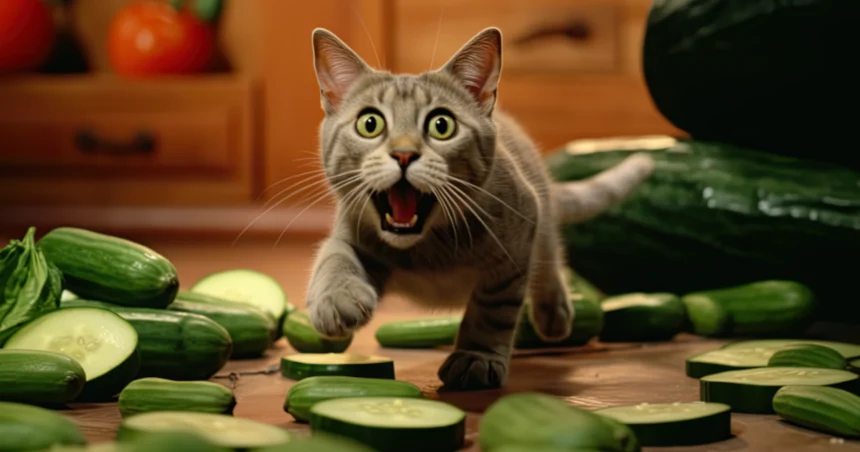Have you ever seen those viral cat videos where kitties freak out when they spot a cucumber? It’s pretty hilarious to watch their startled jumps and hasty retreats from the harmless veggie. But why do cucumbers scare cats so darn much? The phenomenon has sparked a ton of curiosity, and science has some insights into the possible reasons behind this feline fear.
In this article, we’ll take a closer look at why cats are so afraid of cucumbers. From their natural instincts to the resemblance to predators, we’ll unpack the theories on this quirky cat behavior. Let’s get to the bottom of the feline-cucumber fear!
The Internet Phenomenon: Cats and Cucumbers

The internet has gone wild for those videos of cats freaking out around cucumbers. In the clips, a stealthy owner places a cucumber behind an unsuspecting kitty. When the cat eventually notices the vegetable, they leap up in a panic and scramble away. Their eyes get huge, their fur stands on end, and you can almost hear them yelling “What is that thing?!” The startled felines will often run and hide, wanting to get as far from the scary cuke as possible.
These videos went viral in a nanosecond, and humans can’t seem to get enough of cats’ dramatic cucumber fear. The clips rack up millions of views as people are endlessly amused and bewildered. We just have to know – why do cucumbers trigger such intense alarm in cats? There are no loud noises or quick movements, yet they act like the veggie is going to attack them! The phenomenon has sparked a ton of curiosity, laughter, and even some criticism of cat owners “pranking” their pets. But the viral videos shining a spotlight on this quirky feline fear have left us scratching our heads. What is it about cucumbers that freaks cats out so much?
Understanding Cat Behavior: A Brief Overview

To understand why cats are so scared of cucumbers, it helps to look at some of the basics of feline behavior and instincts. As prey animals, cats are hardwired to be cautious and alert to potential threats. Their senses are highly tuned to detect anything unusual in their environment that could signal danger. Cats inherently dislike loud noises, quick movements, and unfamiliar objects, as these things can seem threatening. Their first instinct is to get away from anything perceived as risky.
Cats also rely heavily on eyesight and can be startled by something suddenly appearing in their line of vision. Their vision is adapted to detect motion very easily, an ability that is life-saving for spotting predators in the wild. But this heightened visual sense means harmless objects can set off their alarms if they seem to “appear” out of nowhere. Additionally, cats have a powerful early warning system – their whiskers. Whiskers detect subtle air currents and vibrations, alerting cats to approaching danger. Anything brushing or touching their whiskers unexpectedly is sure to evoke a fearful reaction.
Understanding these ingrained cat instincts gives us some clues into why the sudden sight of a cucumber may trigger their inner alarms and fearful escape response. Those instincts are just below the surface, even for our domestic house cats.
Scientific Explanation: Why Are Cats Afraid of Cucumbers?

When looking at the cat-cucumber phenomenon, science can help explain what exactly is triggering their intense fear reaction. One of the main factors is the sudden and unexpected appearance of the cucumber from a cat’s point of view. Remember, cats inherently react fearfully to quick movements and unfamiliar objects that seem to come out of nowhere. When focused on something like grooming or eating, their radar is down. So that stealthy cucumber placed silently behind them takes them completely by surprise when they finally notice it.
Cats also have poor near-vision, meaning objects directly in front of their nose or under their chin are blurry. So a cucumber placed close by can seem extra alarming when they turn and it “magically” appears right in their face. The unfamiliar shape and patterns on the cucumber’s skin add to the effect. One theory suggests the dark green color and light spots may resemble the skin of common cat predators like snakes. So their instincts kick in, warning them of danger.
Additionally, the cucumber’s elongated shape triggers a reaction. One study found that cats reacted fearfully to cucumbers but not to square-shaped objects. The snake-like form just sends their alarm bells ringing. And when an item touches their whiskers, those sensitive detectors send signals straight to their amygdala, inducing the classic fight-or-flight response.
So while we can’t know exactly what’s going on in a cat’s mind when they encounter a cucumber, science indicates the sudden appearance, unfamiliar shape and textures, and resemblance to predators are likely triggering their hardwired instincts to flee from impending danger. To cats, cucumbers just hit all the marks of something potentially threatening – even though we know they’re just yummy vegetables!
Potential Harm to Cats from This Fear

While the cucumber fear makes for cute viral videos, it’s important to realize this phenomenon can actually stress cats out and even harm them. When cats are continually startled by the sudden appearance of cucumbers, it creates ongoing anxiety and apprehension. Their fight-or-flight response is activated each time, flooding their system with stress hormones. Over time, chronic stress can weaken cats’ immune systems and cause other health issues.
So while you may be tempted to put cucumbers around your house to test your own cat’s reaction for amusement, it’s not a great idea. The frights are real for them, and repeated stress is unnecessary and unkind. The phenomenon highlights just how sensitive cats are to perceived threats and how alarming the unfamiliar can be. Let’s not add unnecessary stress by deliberately scaring our pets! Going viral shouldn’t come at the cost of cat wellbeing.
How to Help Your Cat Overcome This Fear?

If your cat is one who startles at the sight of cucumbers, there are some things you can do to help them overcome the fear. First, never force them close to a cucumber or trap them near one. This will just further their anxiety. Instead, gently expose them to cucumbers in a positive environment. Place a cucumber far across the room and reward them with treats for calm behavior. Slowly move it closer as they remain relaxed. Let them sniff and paw at it as they build confidence.
Challenge their instincts gradually and give them control. If they ever react strongly, move the cucumber farther away again. With time and positive reinforcement, your cat can learn cucumbers aren’t something to fear. Maintaining a stress-free environment is key, so they associate cucumbers with rewards, not fright. With patience and care, you can help your feline friend get over their funny phobia and make cucumbers less scary.
Conclusion
The phenomenon of cats afraid of cucumbers certainly provides amusing viral video fodder. But it also highlights important truths about respecting our furry friends. Cats have instincts and fears we may not fully understand but should aim to respect. While we can gently help them overcome alarms, we should never deliberately scare them for our own entertainment.
In the end, the feline-cucumber fear reminds us that cats perceive the world much differently than their human companions. So let’s remember to be patient, provide security, and never insist our pet pals face anything that causes them distress, be it cukes or otherwise.


